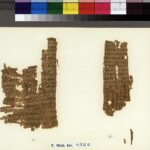| Artefact ID | 402 |
| TM ID | TM 64586 |
| Findspot (DEChriM ID) | - () | Class | Textual |
| Material | Papyrus |
| Writing medium | Uncertain |
| Text content | Literary |
| Language | Greek |
| Description | ZPE 93 (1992): 180-186; P.Mich. inv. 4922; MP[3] 1549.01 Two papyrus fragments with a Christian text. The Christian text (probably a commentary on Exodus or a homily) was written on the blank space of a text containing Xenophon Cyropaedia 2.1.10-12 and 2.2.19-20, thus making it an opisthograph. The ed. pr. compares the format to P.Ryl. III 466 (7/8 c., Fayûm) and P.Köln VII 297 (4/5 c., provenance N/A). Fragment A (8 x 13 cm) preserves parts of two columns of text, and a 3 cm tall bottom margin, while fragment B (4.3 x 10.7 cm) preserves parts of one column. It is estimated that 24 columns of of the Cyropaedia had originally separated fragment A and B . The text of Xenophon is written in an elegant, round script along the fibres on both sides of both fragments. The lettering is decorated with serifs, loops, paragraphoi and diple obelismene. The Christian text is written in multiple angles, apparently in order to fit in the blank spaces around the existing text. On fragment A, the Christian text is written along the fibres on both the recto and verso, over the original text and intralinearly. On fragment B, the Christian text is written perpendicular to the fibres, and along the fibres on the verso. Although these are clear indications that the papyrus roll has been repurposed in a Christian context, the text cannot be considered a palimpsest as there were no apparent attempts to remove the original text of Xenophon; see ed. pr. The impression is that the roll has been cut before being reused, which could explain the variation in writing directions exhibited by the new text. The Christian text is written in a sloping, bold majuscule, with some ligatures and marked diaereses before word-initial upsilon. The impression is of haste and informality; see ed. pr. The text presents an unidentified Christian text commenting on three scenes from the Exodus: The crossing of the Red Sea, the springs of Merra, and the discovery of twelve springs and seventy palms in Aelim. The ed. pr. suggests that the text is either a homily or a commentary concerned with the Exodus, or that it may have had a cathegetical function. The story continues (in proper sequence) from fragment A to B, where the verso of fragment B precedes the recto. |
| Selection criteria | Literary genre (Non-canonical), Literary genre (Theological), Subliterary genre (Liturgical) |
| Date from | 300 |
| Date to | 499 |
| Dating criteria | Palaeography. The older text of Xenophon is written in an elegant and practised round script, decorated with serifs, loops, and diple and can be placed in the 1st or 2nd c. The Christian text is written in a sloping majuscule, and was placed in the 4/5 c. by the ed. pr. through comparison with P.Oxy. XXVII 2459 (4th c., Oxyrhynchus) and P.Egerton 5 (late 4/early 5th c., Greek/Coptic religious text). |
| Absolute/relative date | Relative date |
| Archaeological context | Provenance and findspot are uncertain. The fragments were acquired by Sir Harrod Idris Bell in 1926/1927. |
| Accession number | Ann Arbor, Michigan University, Library P. 4922 a and b |
ARTEFACT IDENTIFIERS
BIBLIOGRAPHY
Editio princeps
∙ Dillery, John D., and Traianos Gagos. 1992. "P. Mich. Inv. 4922: Xenophon and an Unknown Christian Text with an Appendix of All Xenophon Papyri." Zeitschrift Für Papyrologie Und Epigraphik 93. 171-90 and plate no. 6.
Additional bibliography
∙ Rahlfs, Alfred and Detlef Fraenkel. 2004 (1914). Verzeichnis der griechischen Handschriften des Alten Testaments. Göttingen. 10-11.
Authors
Suggested citation
External links


 Json data
Json data





